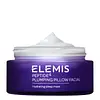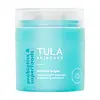What's inside
What's inside
 Key Ingredients
Key Ingredients

 Benefits
Benefits

 Concerns
Concerns

 Ingredients Side-by-side
Ingredients Side-by-side

Water
Skin ConditioningPEG-8
HumectantDicaprylyl Carbonate
EmollientGlycerin
HumectantDiheptyl Succinate
EmollientCapryloyl Glycerin/Sebacic Acid Copolymer
Skin ConditioningSodium Polyacrylate
AbsorbentPhenoxyethanol
PreservativeHydroxyacetophenone
AntioxidantParfum
MaskingDisodium EDTA
Chondrus Crispus Extract
Skin ConditioningBuglossoides Arvensis Seed Oil
EmollientBenzyl Benzoate
AntimicrobialGlyceryl Acrylate/Acrylic Acid Copolymer
HumectantBenzyl Alcohol
PerfumingLinalool
PerfumingMaltodextrin
AbsorbentLimonene
PerfumingLithothamnion Calcareum Extract
Skin ConditioningTocopherol
AntioxidantVeronica Officinalis Flower/Leaf/Stem Extract
AstringentHexyl Cinnamal
PerfumingDehydroacetic Acid
PreservativeNyctanthes Arbor-Tristis Flower Extract
Skin ConditioningCananga Odorata Flower Oil
MaskingCitrus Aurantium Dulcis Peel Oil
MaskingMyristica Fragrans Kernel Oil
MaskingGardenia Florida Fruit Extract
Skin ConditioningHydrolyzed Yeast Protein
Skin ConditioningSodium Benzoate
MaskingCitric Acid
BufferingCitrus Aurantium Amara Leaf/Twig Oil
MaskingCitrus Aurantium Amara Peel Oil
Skin ConditioningCoriandrum Sativum Fruit Oil
MaskingBenzoic Acid
MaskingEthylhexylglycerin
Skin ConditioningWater, PEG-8, Dicaprylyl Carbonate, Glycerin, Diheptyl Succinate, Capryloyl Glycerin/Sebacic Acid Copolymer, Sodium Polyacrylate, Phenoxyethanol, Hydroxyacetophenone, Parfum, Disodium EDTA, Chondrus Crispus Extract, Buglossoides Arvensis Seed Oil, Benzyl Benzoate, Glyceryl Acrylate/Acrylic Acid Copolymer, Benzyl Alcohol, Linalool, Maltodextrin, Limonene, Lithothamnion Calcareum Extract, Tocopherol, Veronica Officinalis Flower/Leaf/Stem Extract, Hexyl Cinnamal, Dehydroacetic Acid, Nyctanthes Arbor-Tristis Flower Extract, Cananga Odorata Flower Oil, Citrus Aurantium Dulcis Peel Oil, Myristica Fragrans Kernel Oil, Gardenia Florida Fruit Extract, Hydrolyzed Yeast Protein, Sodium Benzoate, Citric Acid, Citrus Aurantium Amara Leaf/Twig Oil, Citrus Aurantium Amara Peel Oil, Coriandrum Sativum Fruit Oil, Benzoic Acid, Ethylhexylglycerin
Water
Skin ConditioningGlycerin
HumectantButylene Glycol
HumectantDiglycerin
HumectantMethyl Gluceth-20
HumectantNiacinamide
SmoothingPentylene Glycol
Skin ConditioningLactococcus Ferment Lysate
Skin Conditioning3-O-Ethyl Ascorbic Acid
Skin ConditioningBetula Alba Juice
AstringentPanthenol
Skin ConditioningTetrahydrodiferuloylmethane
AntioxidantBeta Vulgaris Root Extract
Skin ConditioningAscorbyl Glucoside
AntioxidantInulin
Skin ConditioningMandelic Acid
AntimicrobialLactic Acid
BufferingCurcuma Longa Root Extract
MaskingHippophae Rhamnoides Fruit Extract
Skin ConditioningCopper Gluconate
Skin ConditioningMagnesium Aspartate
Skin ConditioningZinc Gluconate
Skin ConditioningPrunus Armeniaca Kernel Oil
MaskingLactobacillus Ferment
Skin ConditioningLactobacillus
Skin ConditioningAlpha-Glucan Oligosaccharide
CleansingTromethamine
BufferingSodium Polyacrylate Starch
AbsorbentCarbomer
Emulsion StabilisingAcrylates/C10-30 Alkyl Acrylate Crosspolymer
Emulsion StabilisingXanthan Gum
EmulsifyingAmmonium Acryloyldimethyltaurate/Vp Copolymer
Ethylhexylglycerin
Skin ConditioningTriethyl Citrate
Masking1,2-Hexanediol
Skin ConditioningPolymnia Sonchifolia Root Juice
Skin ConditioningCitrus Aurantium Dulcis Peel Oil
MaskingHelianthus Annuus Seed Oil
EmollientMaltodextrin
AbsorbentSodium Benzoate
MaskingSodium Chloride
MaskingCitrus Reticulata Peel Oil
MaskingEugenia Caryophyllus Flower Extract
AstringentVanilla Planifolia Fruit Extract
Skin ConditioningPhenoxyethanol
PreservativeTocopherol
AntioxidantCI 19140
Cosmetic ColorantCI 17200
Cosmetic ColorantWater, Glycerin, Butylene Glycol, Diglycerin, Methyl Gluceth-20, Niacinamide, Pentylene Glycol, Lactococcus Ferment Lysate, 3-O-Ethyl Ascorbic Acid, Betula Alba Juice, Panthenol, Tetrahydrodiferuloylmethane, Beta Vulgaris Root Extract, Ascorbyl Glucoside, Inulin, Mandelic Acid, Lactic Acid, Curcuma Longa Root Extract, Hippophae Rhamnoides Fruit Extract, Copper Gluconate, Magnesium Aspartate, Zinc Gluconate, Prunus Armeniaca Kernel Oil, Lactobacillus Ferment, Lactobacillus, Alpha-Glucan Oligosaccharide, Tromethamine, Sodium Polyacrylate Starch, Carbomer, Acrylates/C10-30 Alkyl Acrylate Crosspolymer, Xanthan Gum, Ammonium Acryloyldimethyltaurate/Vp Copolymer, Ethylhexylglycerin, Triethyl Citrate, 1,2-Hexanediol, Polymnia Sonchifolia Root Juice, Citrus Aurantium Dulcis Peel Oil, Helianthus Annuus Seed Oil, Maltodextrin, Sodium Benzoate, Sodium Chloride, Citrus Reticulata Peel Oil, Eugenia Caryophyllus Flower Extract, Vanilla Planifolia Fruit Extract, Phenoxyethanol, Tocopherol, CI 19140, CI 17200
Ingredients Explained
These ingredients are found in both products.
Ingredients higher up in an ingredient list are typically present in a larger amount.
Citrus Aurantium Dulcis Peel Oil is oil from the peel of an orange fruit.
Limonene and linalool make up the majority of oils from citrus peels. Limonene has a "citrus" fragrance. Citrus peels also contain flavonoids, which have anti-inflammatory properties.
Citrus peel is also a rich source of flavonoids. Flavonoids are natural antioxidants and help protect your skin against damage. Flavonoids are a group of compounds naturally found in vegetables and fruits.
The term 'fragrance' is not regulated in many countries. In many cases, it is up to the brand to define this term. For instance, many brands choose to label themselves as "fragrance-free" because they are not using synthetic fragrances. However, their products may still contain ingredients such as essential oils that are considered a fragrance.
Learn more about Citrus Aurantium Dulcis Peel OilEthylhexylglycerin (we can't pronounce this either) is commonly used as a preservative and skin softener. It is derived from glyceryl.
You might see Ethylhexylglycerin often paired with other preservatives such as phenoxyethanol. Ethylhexylglycerin has been found to increase the effectiveness of these other preservatives.
Glycerin is already naturally found in your skin. It helps moisturize and protect your skin.
A study from 2016 found glycerin to be more effective as a humectant than AHAs and hyaluronic acid.
As a humectant, it helps the skin stay hydrated by pulling moisture to your skin. The low molecular weight of glycerin allows it to pull moisture into the deeper layers of your skin.
Hydrated skin improves your skin barrier; Your skin barrier helps protect against irritants and bacteria.
Glycerin has also been found to have antimicrobial and antiviral properties. Due to these properties, glycerin is often used in wound and burn treatments.
In cosmetics, glycerin is usually derived from plants such as soybean or palm. However, it can also be sourced from animals, such as tallow or animal fat.
This ingredient is organic, colorless, odorless, and non-toxic.
Glycerin is the name for this ingredient in American English. British English uses Glycerol/Glycerine.
Learn more about GlycerinMaltodextrin is a polysaccharide. It is derived from starch such as rice, corn, wheat, or potato starch.
In food, Maltodextrin is used to improve the texture and thicken a product. Due to its structure, it can help create a gel texture. As an emulsion stabilizer, it helps keep the ingredients in a product together.
As a polysaccharide, Maltodextrin has moisturizing properties. Polysaccharides are a type of carbohydrate. The top layer of skin uses polysaccharides to retain water, keeping the skin hydrated.
Maltodextrin is water soluble and has a sweet taste.
Learn more about MaltodextrinPhenoxyethanol is a preservative that has germicide, antimicrobial, and aromatic properties. Studies show that phenoxyethanol can prevent microbial growth. By itself, it has a scent that is similar to that of a rose.
It's often used in formulations along with Caprylyl Glycol to preserve the shelf life of products.
Sodium Benzoate is a preservative. It's used in both cosmetic and food products to inhibit the growth of mold and bacteria. It is typically produced synthetically.
Both the US FDA and EU Health Committee have approved the use of sodium benzoate. In the US, levels of 0.1% (of the total product) are allowed.
Sodium benzoate works as a preservative by inhibiting the growth of bacteria inside of cells. It prevents the cell from fermenting a type of sugar using an enzyme called phosphofructokinase.
It is the salt of benzoic acid. Foods containing sodium benzoate include soda, salad dressings, condiments, fruit juices, wines, and snack foods.
Studies for using ascorbic acid and sodium benzoate in cosmetics are lacking, especially in skincare routines with multiple steps.
We always recommend speaking with a professional, such as a dermatologist, if you have any concerns.
Learn more about Sodium BenzoateTocopherol (also known as Vitamin E) is a common antioxidant used to help protect the skin from free-radicals and strengthen the skin barrier. It's also fat soluble - this means our skin is great at absorbing it.
Vitamin E also helps keep your natural skin lipids healthy. Your lipid skin barrier naturally consists of lipids, ceramides, and fatty acids. Vitamin E offers extra protection for your skin’s lipid barrier, keeping your skin healthy and nourished.
Another benefit is a bit of UV protection. Vitamin E helps reduce the damage caused by UVB rays. (It should not replace your sunscreen). Combining it with Vitamin C can decrease sunburned cells and hyperpigmentation after UV exposure.
You might have noticed Vitamin E + C often paired together. This is because it is great at stabilizing Vitamin C. Using the two together helps increase the effectiveness of both ingredients.
There are often claims that Vitamin E can reduce/prevent scarring, but these claims haven't been confirmed by scientific research.
Learn more about TocopherolWater. It's the most common cosmetic ingredient of all. You'll usually see it at the top of ingredient lists, meaning that it makes up the largest part of the product.
So why is it so popular? Water most often acts as a solvent - this means that it helps dissolve other ingredients into the formulation.
You'll also recognize water as that liquid we all need to stay alive. If you see this, drink a glass of water. Stay hydrated!
Learn more about Water